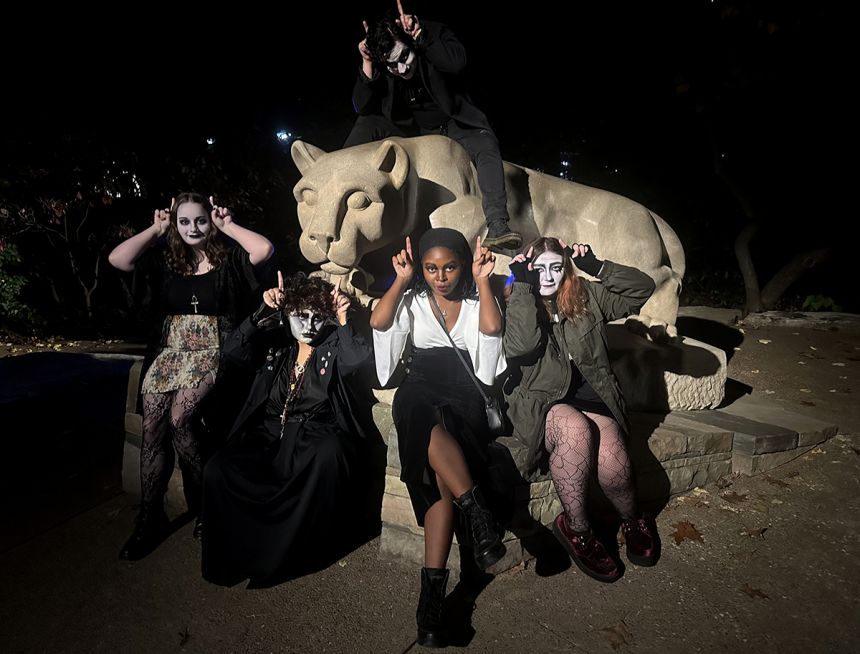January 18, 2024
Traditionally white Goth subculture provides a home for all races

A few members of the PSU Goths visit Penn State's Nittany Lion Shrine on Oct. 28, 2023. Pictured are Ayden Herold (top) and (bottom, left to right) Anna George, Felix Araujo, Jaden Jones and Phoenix Jenkins.
Credit: Courtney BenedettoSTATE COLLEGE, Pa. — When Felix Araujo left his hometown of Hillsdale, New Jersey – population 10,087 – to join a student body more than four times that size, he had great hopes. Surely, he would find more people like himself.
And by that he meant more Goths – people who walked around campus in black platform boots, black trench coats and enough dark makeup to blanket their eyelids. People who listened to the slow, sad sounds of bands like Siouxsie and the Banshees, The Cure and Twin Tribes.
But Araujo deviates from the pallid Goth norm in one significant way: In a predominately white subculture, Araujo is a Hispanic outlier. Preparing for a night out, he combines pale foundation with white mixing pigment to cover his caramel complexion.
Would he find a place for himself at Penn State?
Flash forward more than a year. When Araujo realized there was no group where Nittany Goths could come together, he created one. And in that group, he has found acceptance and camaraderie with Goths of all colors.
“We're all different, according to society's standards,” Araujo said. “So, you can't exclude people just because they're weird, because then you’re doing the same thing that people were doing to you.”
Araujo, now a sophomore, made an Instagram account for Goths at Penn State in September, and the group of “bats” that joined have been inseparable since. They’ve watched “The Rocky Horror Picture Show,” given presentations on what it means to be Goth and helped each other practice stark black-and-white makeup looks.
On nights out, they flock like a murder of crows to local State College house shows where they sway to melancholy melodies and headbang to punk college bands.

Jaden Jones, the vice president of PSU Goths, packs her coffin-shaped backpack after doing her traditional Goth makeup on Dec. 12, 2023, in Penn State's Wolf Hall.
Credit: Courtney BenedettoIt’s in those basements, garages and living rooms with small makeshift stages, with their multicolored lights and blasting speakers, that Jaden Jones has “never felt more at home.”
Jones, daughter of Jamaican immigrants, was one of the first people to encourage Araujo to start a club for Goths. Like Araujo, she always had a love for alternative culture and punk music, but she really wanted to explore Goth as part of her identity.
Now Jones is the vice president of the Goth Club at Penn State and reminds everyone that people of color embody the dark aesthetic and should embrace it.
Jones, Araujo said, makes him feel “a little less alone.”
Dark roots
In the post-punk era of the late 1970s and early 1980s, Goth emerged as a new sound with rock undertones accompanied by dark, melancholic melodies. A common theme among band members of The Cure and Bauhaus was wearing black clothing, dark makeup and fabrics like leather and fishnets. Fans of the music adopted the fashion.
Universal values emerged as well. The somber music and lyrics turned into a shared appreciation of life’s melancholy side and living outside the mainstream. The macabre makeup, mimicking pale corpses with sunken eyes, was inspired by the acceptance of death. Goths were drawn to all things dark, things that challenged societal norms.
Jones said Goth combines punk’s mentality to fight for the oppressed and “screw the establishment” with love for the macabre aesthetic.
“Because we signed the contract of being alive means that one day, we're all going to kick it, and bad things happen throughout life,” Jones said. “Rather than shy away from all of the darkness and everything that could happen to you, embrace it because it’s not going to go away.”
Now a forensic science major, Jones felt drawn to the darker side of life during middle school. Her teenage angst turned into a love of punk music and black clothing, so when she had the freedom to be anyone she wanted in college, Goth was a natural step forward. She did her research and queued Goth classics.
Araujo was the high school student who fit in best with the kids who didn’t fit in. He liked anime and manga, watched horror movies and associated with the theatre kids. After discovering the music, Goth became another welcoming community of misfits that he could call home.
But it isn’t necessarily easy for Goths of color to embrace the lifestyle. For one thing, the popular Goth bands are all white, seemingly as far from Black popular music as Bach and Beethoven, Aerosmith and AC/DC. The same goes for Goth fashion.
Jones said she’s been called “whitewashed” by other Black people. In high school, she listened to alternative artists like Twenty One Pilots and “felt like (she) didn't really fit in with other Black students.”
Araujo, at home with his Catholic, Hispanic family, felt a great divide between his identities. His father, he said, is still under the impression that Hispanics can’t be Goth, even though he’s come to accept his son’s style.
He said he feels out of place attending events for Hispanic clubs at Penn State because he stands out when he dresses in black and layers chains and crosses around his neck.
“I feel a little ostracized because, yeah, I don't dress like you guys, but I'm still Hispanic like you guys,” Araujo said. “I'm not trying to be white.”
As he works to find balance between his conflicting identities, Araujo is confident that he won’t turn his back on the subculture that makes him stand out in a crowd.
“I regret not embracing myself sooner,” Araujo said.
Efforts have been made elsewhere to make room for Black people in the Goth universe. Anastasia Du Noire organizes Slings and Arrows, a series of Goth events in Washington, D.C., that are “pretty much just dedicated to giving a space to Black Goth people” at various nightclubs in the city.
Du Noire, 23, used to work with another Goth night in Washington, but when they realized how few people of color were showing up to the events, they knew it was time to create a more inclusive environment.
“I am trying to be the representation that I want to see,” Du Noire said. “And I think if we have a lot more people of color that make it their goal to be the representation that they want to see, then I think that we can definitely see some changes.”
Anya Gibson, a Black business owner from Atlanta, is aiming to foster a sense of community for Goth people of color and make them feel heard through her Goth clothing designs.
Gibson, 29, launched her online clothing store, Three of Swords, in 2020. Her mission is to spread a message of inclusivity among the subculture by only hiring models of color to showcase her products.
Arguing that Goth and non-white cultural identities can coexist, Du Noire said while the subculture itself is traditionally white, people often overlook the fact that Black people influenced the themes in the music.
Bauhaus “used the sound of Jamaican dub in their music, which effectively is the reason why we have in Goth music the jangly, ethereal guitars,” Du Noire said.

Jaden Jones, the vice president of PSU Goths, works the DJ booth at Penn State's student radio station, The Lion 90.7fm, on Dec. 8, 2023. Jones will launch her show "Roots, Rock, Reggae" in the spring.
Credit: Courtney BenedettoNavigating her own conflicting and intersecting identities, Jones has created a radio show called “Roots, Rock, Reggae.” Starting in the spring semester, Jones will explore the history of Jamaican influence on different genres of music every Friday on the Lion 90.7 FM, Penn State’s student radio. Araujo, she says, will be the first guest.
“I wanted to combine (the) two pieces of my identity that I hold near and dear to my heart,” Jones said, “being Jamaican and being alternative.”
She insists that “it’s OK to be a minority and still be alt. That doesn't make you any less part of the minority. You're not any less Black, Hispanic or Asian or any other identity just because you identify with a traditionally white subculture.”
Good times
Do not be deceived by their lugubrious style. Goths – at Penn State and elsewhere – like to have fun, if only in their own way.
The “Spooky Valley” Goths pulled together an Infernal Council, led by the Arbiter of Demons and High Executioner along with their Technomancer, Head Scribe, Bone Collector and Minister of Propaganda, hoping to join the 1,000 recognized student organizations at Penn State in their own fashion.
After submitting their constitution for approval, the Goths are now listed on OrgCentral's website with their mission to uphold a "community of the strange, dark and mysterious." They are officially known as the Goth Club at Penn State.
Like any college club, the Goths host bake sales, meet in the library for slideshow presentations and take pictures with Santa.
At Penn State’s Nittany Lion Shrine, where families in blue-and-white often gather for snapshots, a more unusual scene unfolded during this past “Hallo-weekend.”
Five students wearing an assortment of black boots, skirts, trench coats, fishnets, layers of jewelry, white faces, and haunting black eyes and lips stood in line to take pictures. The ghoulish group looked dead at the camera, posing with their fingers pointing to the sky like devil horns.
A man and woman decked out in Penn State gear took notice.
“Wow, you guys have great costumes!” the woman said.
“Are you going as Kiss?” the man asked, really hoping that one of them would stick their tongue out like Gene Simmons.
No, said one student in a long black trench coat, his short hair teased in a wild hive. “We’re the Goth Club.”
And together the Goths rode into the night for a club member dinner — at Olive Garden.
“If you told freshman me at this time last year, ‘Oh, you would be in a club with 20 other people having house parties and dancing to Goth music and getting all Gothed up and not feeling scared or ashamed or embarrassed,’ I wouldn't believe you,” Araujo said. “I've always wanted that, so I'm so happy with how things are right now.”